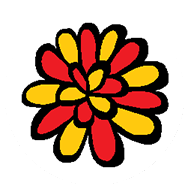Enshu-bana (遠州花, lit. “Enshu Flowers”) is a Hana-Awase variant played in the Shizuoka Prefecture of Japan. Locally, it is known as Shishibochūshin (ししぼちゅうしん), after the highest scoring yaku in the game consisting of the Boar, the Butterflies, and the Rainman.
Many different variants of this game exist on the region, depending on where it is played and who are playing. It seems only the list of dekiyaku is consistent throughout all variants.
¶ Playing with Wagers
The following game is designed for 2 to 3 players. At every round, players place a wager into the pot, and dealer deals the cards. Players then check for teyaku in their hand and expose them if they have any. Afterward, the gameplay is the same as Hana-awase, and play continues until all players’ hands run out of cards.
Players then count their card points, plus the value of dekiyaku formed, plus 50 points if the Triplet teyaku is formed during the round. The player with the highest score wins the round and takes the pot.
¶ Uchikiriyaku (Round-stopping Yaku)
There are some teyaku and dekiyaku that stop the round. They are called Uchikiriyaku (打ち切り役, “termination yaku”).
If a player forms one of these yaku at any point in the game, he/she immediately wins the round; the round is stopped, all points scored during the round are forfeited, other players place more wagers into the pot according to the value of the yaku, and the winner then takes the pot.
¶ Card Values
The card values used in Enshu-bana are slightly different from those used in Hachi-Hachi. The Rainman is considered an Animal instead of a Bright, and all Chaffs are worth 0 points.
| Card Type | Value | Number in Deck |
|---|---|---|
| Bright | 20* | 4 |
| Animal | 10 | 10 |
| Ribbon | 5 | 10 |
| Chaff | 0 | 24 |
Some play such that Brights are worth 30 points.
¶ Teyaku
| Value | Name of Yaku | Composition |
|---|---|---|
| 10x the wager | Four-Three (Shisou) | Four cards of the same month plus Three cards of another month. (STOPS THE ROUND) |
| 2x the wager | Four of a Kind (Teshi/Shihon) | Four cards of the same month. (STOPS THE ROUND) |
| 50 pts. | Triplet (Sanbon) | Three cards of the same month. Only Iris |
¶ Dekiyaku
¶ Playing for Points (Simplified Variant)
This is a simplified version of the above game for two or three players, with the gambling element removed.
In this game, none of the yaku stops the round; the round only ends when all players run out of cards.
Players then count their card points, and if they formed a yaku, they either add the yaku’s value to their score or multiply their score, depending on the yaku. The player with the highest score wins the round.
Locally, matchsticks were typically used for tracking points in the game, in similar fashion to go stones in Hachi-hachi or chips in western gambling games. In addition, each player has their own matchbox, which was used similarly to a player’s scoring basket in Hachi-hachi.
¶ Teyaku
| Value | Name of Yaku | Composition |
|---|---|---|
| 50 pts. | Four-Three (Shisou) | Four cards of the same month plus Three cards of another month. |
| 50 pts. | Triplet (Sanbon) | Three cards of the same month. Only Iris |
Playing with Teyaku is optional; some play without Teyaku.
¶ Dekiyaku
¶ Comprehensive Enshu-bana variant (for 2-5 players)
This version of the game has been passed down by the master of Omitsu, a Hanafuda Youtuber. It is by far the most detailed version of Enshu-bana.
¶ Initial Setup
Each player starts with an equal amount of matchsticks, which are placed inside each player’s matchbox.
The dealer is chosen as usual, and the cards are dealt to each player- 7 cards to each player and 6 to the field (regardless of the number of players), with the remainder placed face-down on the field as the draw pile.
¶ Misdeals
The cards are reshuffled and re-dealt if:
- There are four cards of the same month on the field, or
- There are three cards of either the Iris
 , Chrysanthemum
, Chrysanthemum , or Paulownia
, or Paulownia suit on the field.
suit on the field.
¶ Field Multiplier
After the cards have been dealt, the number of Bright cards on the field is counted to determine the field multiplier.
This multiplier applies to the amount of matchsticks paid to the winner during a specific round.
- If there are no Bright cards on the field, the payments are not multiplied.
- If there is one Bright card on the field, the payments are multiplied by 2.
- If there are two Bright cards on the field, the payments are multiplied by 3.
- If there are three Bright cards on the field, the payments are multiplied by 4.
- If there are four Bright cards on the field, the payments are multiplied by 5.
The field multiplier is then confirmed by placing a number of matchsticks on the field equal to the number of Bright cards present on the field. (In other words, the multiplier number is equal to the number of matchsticks on the field plus 1.)
For this purpose, you must use a spare box of matchsticks that do not belong to any person’s score.
¶ Kotsu (Raising the Multiplier)
After the field multiplier is confirmed, each player, starting with the dealer counterclockwise, declares whether or not they want to increase the field multiplier for the current round.
- Declare “kotsu!” if you want to increase the field multiplier by 1. Add one matchstick from the spare box onto the field.
- Declare “nashi!” if you do not want to increase the field multiplier.
¶ Mizu-Kotsu (Blindly raising the Multiplier)
This unique variant of Hachi-Hachi’s Mizuten rule allows players to raise the field multiplier before the cards have been dealt.
- At the beginning of the round, before the dealer starts to distribute the cards, each player may declare “mizu-kotsu!” to increase the field multiplier by 1. Add one matchstick from the spare box onto the field.
Players who declared “mizu-kotsu!” must participate in the flower-matching phase during the round, and cannot drop out (dropout rules will be explained later).
Only a maximum of three players are allowed to declare “mizu-kotsu!” per round.
Players who declared “mizu-kotsu!” are still allowed to declare “kotsu!” after the cards have been dealt.
¶ The Dropout Phase
Since only 3 players can participate in the flower-matching phase during each round, a Dropout system is implemented which allows players to decide whether to participate in the flower-matching phase or not. The decision to participate depends on how good a player’s hand is, as well as the presence of Teyaku.
Skip this phase if there are only 2 or 3 people playing the game.
- Once all players have finished raising the field multiplier, each player, starting with the dealer counterclockwise, declares whether to “join in” to participate in flower-matching phase, or “drop out” if they don’t want to participate until the next round.
- If 4 or more players declared to “join in”, then the field multiplier is raised by 1 (place one matchstick from the spare box onto the field), and the dropout phase is repeated.
- If there are 3 remaining players who have not declared to “drop out”, they must participate in the flower-matching phase. (i.e. If there are 5 players, if 2 players dropped out, the remaining 3 must join in whether they want to or not. Or if there are 4 players, if 1 player dropped out, the remaining 3 must join in.)
- If the dealer drops out, the player to the dealer’s right gains the dealer’s rights.
The field multiplier and all rules that increase the field multiplier STACK. In this regard, there is no limit to how high the field multiplier can be raised during each round.
¶ The Flower-Matching Phase
Players then check for teyaku in their hand. If they have a teyaku, they announce it and expose the relevant cards (place them face-up on the table near them) to avail the teyaku.
Teyaku that are not announced and exposed before the dealer’s first turn are considered void.
Afterward, the dealer starts their first turn. The gameplay is the same as Hana-awase, and play continues until either all players’ hands run out of cards, or one player forms an Uchikiriyaku.
Regardless of how the round ended, the total score for each player is counted as follows:
Player's Total Score = (Total captured card points - Points from opponents' yaku*) x Total Field Multiplier x Uchikiriyaku multiplier
Opponent’s yaku refers to the teyaku and normal dekiyaku formed by the opponents.
The player who formed the Uchikiriyaku is the winner of the round. If nobody forms an Uchikiriyaku, then the player with the highest score is the winner of the round.
In case of a tie, the dealer, or the player closest to the dealer’s left is considered the winner.
Each of the other players who participated in the flower-matching phase must pay the amount of matchsticks to the winner equal to the winner’s score. (i.e. the winner receives an amount equal to twice their score)
¶ Card Values
| Card Type | Value | Number in Deck |
|---|---|---|
| Bright | 30 | 4 |
| Animal | 10 | 10 |
| Ribbon | 5 | 10 |
| Chaff | 0 | 24 |
¶ Teyaku
All Teyaku of a group are mutually exclusive. Only one Teyaku from Group A can stack with another one Teyaku from Group B.
¶ Group A. Set Teyaku
| Value | Name of Yaku | Composition |
|---|---|---|
| 150 pts. | Four-Three (Shisou) | Four of a Kind + Triplet |
| 100 pts. | Four of a Kind (Shihon) | Four cards of the same month except Iris If there are four Iris |
| 50 pts. | Triplet (Sanbon) | Three cards of the same month. If an Iris |
¶ Group B. Junk Teyaku
| Value | Name of Yaku | Composition |
|---|---|---|
| 100 pts. | All Junk (Soppe) | Seven junk cards not including the Willow |
| 50 pts. | Lone Animal (To Ichi) | One animal card, six junk cards not including the Willow |
| 50 pts. | Lone Ribbon (Tan Ichi) | One ribbon card, six junk cards not including the Willow |
¶ Uchikiriyaku (Dekiyaku that stop the round)
Once a dekiyaku in this group is formed, the round immediately ends, and the player who formed that yaku wins the round. In addition, the winner’s score is multiplied (after applying field multipliers).
¶ Normal Dekiyaku
¶ Fuke
If a player’s total card points is 15 or less (not counting points from Willow![]() cards), they may declare “Fuke!”, which invalidates all points earned during the round.
cards), they may declare “Fuke!”, which invalidates all points earned during the round.
A player who has exposed their teyaku cannot declare “Fuke!” even if their card points is 15 or less.
¶ Bibliography
- Ichinose, Takeshi “Atarashii Hanafuda Nyuumon"
- https://ameblo.jp/sadako0224/entry-11828677632.html
- http://hanafuda.richmind.net/gamelist
- https://www.youtube.com/channel/UCaIuCUXkqPxZ73Bqymj7wHw/community?lb=Ugkx0gJ8NakJzlRuW2UHYz5q-RK1Ut57AXF5
- https://www.youtube.com/channel/UCaIuCUXkqPxZ73Bqymj7wHw/community?lb=UgkxGhbXWyZNYIgQmlRaTSOeujOYdFEft719